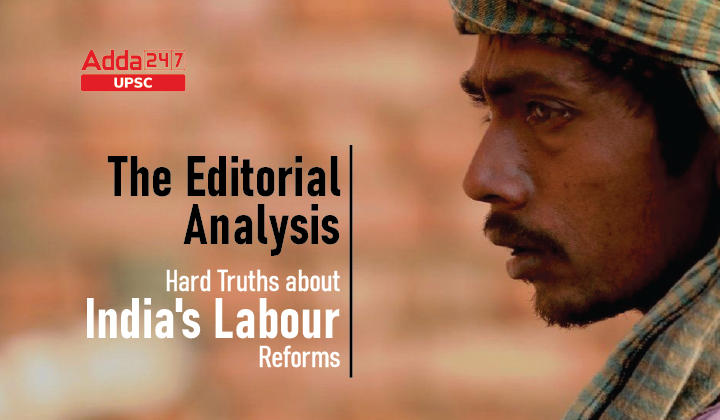Table of Contents
The Editorial Analysis- Hard Truths about India’s Labour Reforms- Relevance for UPSC Exam
General Studies III- Indian Economy and issues relating to planning, mobilization, of resources, growth, development and employment.
Context
Independent India was born at the midnight hour on August 15, 1947, 75 years ago, when India’s first Prime Minister Jawaharlal Nehru unfurled the country’s tricolour flag and announced to Parliament that India had made a “tryst with destiny”.
India had won its independence after a long, remarkably peaceful struggle for freedom, led by Mahatma Gandhi.
Gandhi’s Vision- Gandhi had a vision of a country not divided into fragments by religious and communal walls. He envisioned a country in which all Indians, whether rich or poor, would hold their heads high in dignity. India’s “tryst with destiny” was to provide “poorna swaraj” (i.e., full freedom) to all its citizens: political freedom, social freedom, and economic freedom.
The Country’s Faultlines
- Political liberties and freedoms of speech are being curbed in India. Social equality amongst castes has not been achieved.
- Lower caste citizens continue to live in great indignity and lower caste poor women live in abject poverty in India’s villages. They are among the most oppressed humans on the planet.
- While the numbers of Indian billionaires increased during the COVID-19 pandemic, hundreds of millions of Indians lost their incomes when the country locked down during the pandemic and struggled to find shelter, food, and even drinking water for their families.
- India’s gravest socio-economic problem is the difficulty a vast majority of citizens have in earning good livelihoods which does not just include employment but the poor quality of employment: insufficient and uncertain incomes, and poor working conditions, wherever they are employed — in factories, farms, service establishments, or homes.
The Labour Reforms- Impact
- The V.V. Giri National Labour Institute’s interim report, “Impact Assessment Study of the Labour Reforms undertaken by the States”, provides insights into the impacts of the reforms so far.
- The report spans the period 2004-05 to 2018-19. It focuses on six States which have implemented reforms: Rajasthan, Maharashtra, Andhra Pradesh, Tamil Nadu, Jharkhand, and Uttar Pradesh.
- The report reveals that labour laws are only one factor affecting business investment decisions. Investors do not go out to hire people just because it has become easy to fire them. An enterprise must have a growing market for its products, and many things must be put together to produce for the market — capital, machinery, materials, land, etc. not just labour. Therefore, it must be worthwhile to employ more people before firing them.
A Clear Picture
- Reforms of labour laws have had little effect on increasing employment in large enterprises. The report says that the effects of labour reforms cannot be revealed immediately: they will take time.
- The share of employment in plants employing more than 300 people increased from 51.1% to 55.3% between 2010-11 to 2014-15 (the period when the emphasis was on administrative reforms), and then increased less, from 55.3% to 56.3%, in 2017-18, when some States made the bolder reforms favourable for employers. Though overall employment is affected by many factors, the bolder reforms post 2014 were designed to promote larger factories.
- The report says, employment in formal enterprises is becoming more informal. Large investors can afford to use more capital and are also employing increasing numbers of people on short-term contracts, while perversely demanding more flexibility in laws.
- The report defines “formal” employment as the grant of paid leave, a written contract, and some “social security.” An enterprise should not have to employ more than 300 people before it provides these benefits.
- Along with the right to be heard and dignity at work, these are the minimal “essentials” all employers must provide to all those who work for them, whether in small enterprises or domestic help.
- Increasing the threshold of the laws dilutes the rights of association and representation of workers in small enterprises.




 TSPSC Group 1 Question Paper 2024, Downl...
TSPSC Group 1 Question Paper 2024, Downl...
 TSPSC Group 1 Answer key 2024 Out, Downl...
TSPSC Group 1 Answer key 2024 Out, Downl...
 UPSC Prelims 2024 Question Paper, Downlo...
UPSC Prelims 2024 Question Paper, Downlo...
